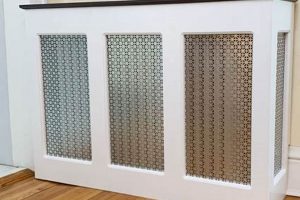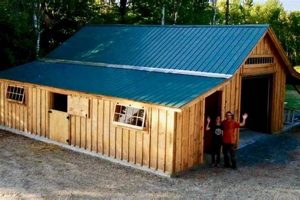A self-assembled or custom-built sliding storage component, often integrated into furniture or cabinetry, represents a practical approach to organization and space optimization. Such projects involve individual construction, modification, or installation of these elements, offering an alternative to purchasing pre-fabricated units. An example might involve constructing a storage solution for a closet using lumber, fasteners, and drawer slides purchased separately.
The appeal of crafting customized storage solutions lies in its adaptability and cost-effectiveness. The ability to tailor dimensions, materials, and finishes to specific needs and existing decor presents a significant advantage. Historically, these personalized projects have provided a means of addressing unique storage requirements within homes and workshops, often driven by resourcefulness and a desire for personalized design.
The subsequent sections will explore various aspects of creating these customized storage solutions, including design considerations, material selection, construction techniques, and installation procedures. These topics aim to provide a thorough understanding of the process, empowering individuals to undertake similar projects successfully.
Essential Considerations for Self-Assembled Storage Components
The following guidance addresses critical aspects of designing, constructing, and installing these units, aiming to enhance functionality and longevity.
Tip 1: Accurate Measurement is Paramount: Prior to commencing construction, meticulous measurements of the intended space are critical. Inaccurate dimensions will result in a poorly fitting unit, compromising functionality and aesthetics. Account for tolerances within the existing structure.
Tip 2: Material Selection Influences Durability: The chosen materials directly impact the structural integrity and lifespan. Solid wood offers superior strength and aesthetic appeal, while engineered wood products like plywood provide a balance of cost and stability. Consider the intended load and environmental conditions.
Tip 3: Proper Fastening Techniques Ensure Stability: Employ appropriate fasteners for the materials being joined. Screws provide greater holding power than nails. Wood glue, when used in conjunction with fasteners, creates a stronger and more durable bond. Ensure fasteners are countersunk to prevent interference with drawer slides.
Tip 4: Drawer Slide Selection Dictates Smooth Operation: Various drawer slide types exist, each with distinct load capacities and extension capabilities. Ball-bearing slides offer smooth and quiet operation, while epoxy-coated slides provide a cost-effective alternative for lighter loads. Consider the weight of the intended contents when selecting slides.
Tip 5: Finishing Enhances Aesthetics and Protection: Applying a finish, such as paint, stain, or varnish, protects the wood from moisture and wear, extending its lifespan. Select a finish that complements the surrounding decor and provides adequate protection against the intended use.
Tip 6: Squareness is Crucial for Functionality: Throughout the construction process, maintain squareness to ensure smooth operation. Use a square to verify that corners are at 90-degree angles. Correct any deviations before proceeding to the next step.
Tip 7: Test Fit Before Final Assembly: Conduct a test fit of the completed unit within its intended space before final assembly. This allows for identification and correction of any fitment issues, minimizing potential complications during installation.
Adhering to these principles contributes to the creation of functional and aesthetically pleasing storage solutions. Attention to detail and adherence to established construction practices are essential for successful project completion.
The subsequent sections will provide more detailed guidance on specific construction techniques and problem-solving strategies.
1. Precise Measurements
Accurate dimensional assessments are fundamental to the successful fabrication and installation of self-assembled storage components. Deviations from specified dimensions compromise functionality, structural integrity, and aesthetic quality. The following facets delineate the importance of precision in the context of customized storage solutions.
- Fitment within Existing Structures
Dimensional accuracy dictates the seamless integration of a storage component into its designated space. Whether fitting within a cabinet frame, closet opening, or other pre-existing structure, precise measurements are crucial. Errors lead to binding, misalignment, and an inability to fully utilize the intended storage space. An undersized component results in unsightly gaps, while an oversized component prevents installation altogether.
- Drawer Slide Functionality
The precise placement of drawer slides relies upon accurate measurements. Variations in drawer width, height, or depth impact the proper alignment and function of these mechanisms. Misalignment results in uneven drawer movement, binding, and premature wear of the slides. Furthermore, inaccurate measurements of the drawer box itself can prevent the slides from engaging properly, rendering the storage solution unusable.
- Material Optimization and Waste Reduction
Precise measurements facilitate efficient material utilization. Accurate calculations of required material quantities minimize waste and associated costs. Conversely, inaccurate measurements necessitate additional material purchases or result in unusable offcuts. This consideration is particularly relevant when working with expensive materials or limited resources.
- Structural Integrity and Longevity
Dimensional accuracy contributes to the overall structural integrity of the storage component. Square and parallel components distribute weight evenly, preventing undue stress on joints and fasteners. Inaccurate measurements can lead to racking, warping, and ultimately, premature failure of the unit. Precise measurements are essential for ensuring the longevity of the investment.
The foregoing discussion underscores the critical role of accurate measurements in the construction of customized storage solutions. Neglecting this foundational element compromises the functionality, durability, and aesthetic appeal of the finished product. Prioritizing precise measurements is essential for achieving a successful outcome.
2. Material Selection
The selection of appropriate materials is a critical determinant in the success of any self-assembled storage component. The chosen material dictates structural integrity, durability, aesthetic appeal, and overall cost-effectiveness. Improper material selection can lead to functional failures, reduced lifespan, and an inability to meet the int
ended storage requirements. For instance, constructing a drawer intended for heavy tools from lightweight fiberboard will likely result in premature failure due to the material’s inadequate load-bearing capacity. Conversely, utilizing an expensive hardwood for a drawer in a seldom-used location represents an inefficient allocation of resources. Therefore, careful consideration of the intended use and environmental factors is essential in guiding material decisions.
The practical implications of material selection extend to the operational characteristics of the storage component. Drawer slide performance, for example, is directly influenced by the material properties of the drawer box. Warping or dimensional instability in the material can cause binding or misalignment, hindering smooth and reliable drawer movement. Similarly, the chosen material affects the ease of finishing and the long-term maintenance requirements of the component. Softwoods, for example, may require more extensive preparation and finishing to achieve a durable and aesthetically pleasing surface compared to hardwoods. A thorough understanding of material properties is therefore necessary to optimize both the functionality and longevity of the self-assembled storage solution.
In summary, material selection represents a pivotal stage in the creation of customized storage solutions. Understanding the inherent properties of different materials, their suitability for specific applications, and their impact on overall cost and performance is paramount. Challenges in material selection often arise from balancing budget constraints with performance requirements and aesthetic preferences. However, a well-informed decision regarding material selection will significantly contribute to the creation of a durable, functional, and aesthetically pleasing storage component that effectively meets the user’s needs.
3. Joint Strength
Joint strength is a critical determinant of the overall structural integrity and longevity of any self-assembled storage component. In the context of drawer construction, robust joints are essential to withstand the stresses imposed by the weight of the drawer’s contents, the friction of sliding, and the repeated opening and closing motions. The failure of a joint can lead to drawer collapse, misalignment, or complete functional impairment. A practical example is a drawer constructed with inadequately secured joints, which, when filled with heavy items, may separate at the corners, rendering the drawer unusable and potentially damaging its contents.
The correlation between joint strength and the overall success of a self-assembled drawer is direct and consequential. Different joint types, such as dovetails, rabbets, or simple butt joints reinforced with fasteners and adhesives, offer varying degrees of strength. The selection of an appropriate joint type must consider the anticipated load and the material properties of the wood or composite material being used. For example, a drawer made of solid hardwood intended for storing tools would require significantly stronger joints, like dovetails, than a drawer made of lightweight plywood intended for storing clothing, where a rabbet joint with screws and glue might suffice. The construction process significantly contributes to the final joint strength; precise cuts, proper clamping during adhesive curing, and correctly sized fasteners are all necessary.
In conclusion, joint strength is not merely a detail, but a fundamental factor governing the performance and lifespan of a self-assembled drawer. Understanding the principles of joint construction, selecting appropriate joint types, and employing sound building practices are essential for creating storage solutions that are both functional and durable. Addressing challenges in achieving adequate joint strength often involves careful material selection, accurate joinery, and the application of suitable fastening and adhesive methods, linking this concept directly to the broader theme of careful and precise DIY craftsmanship.
4. Slide Mechanism
The slide mechanism constitutes a critical functional element in the design and construction of self-assembled drawers. Its primary purpose is to facilitate smooth, controlled movement of the drawer box within its housing. The operational effectiveness of the entire storage solution is contingent upon the selection and proper installation of an appropriate slide mechanism. For example, a poorly chosen or improperly installed slide can lead to binding, uneven movement, or complete functional failure, negating the utility of the drawer itself. Selecting the correct slide mechanism involves consideration of load capacity, extension type (full extension, three-quarter extension, etc.), mounting configuration, and the overall quality of the materials and construction.
The selection of a specific slide mechanism type has direct implications for the practical usability of the self-assembled drawer. Full-extension slides, for instance, allow complete access to the drawer’s contents, while three-quarter extension slides limit access to the rear of the drawer. Load capacity is a crucial factor, as exceeding the rated load can lead to premature wear, deformation, or complete failure of the slide mechanism. The mounting configuration must be compatible with the drawer box construction and the cabinet or furniture housing. For example, undermount slides require specific drawer box construction techniques to ensure proper attachment and functionality. Moreover, the quality of the slide’s internal components, such as ball bearings and lubrication, directly impacts the smoothness and quietness of the drawer’s operation. In a high-end kitchen, silent and smooth operation is desirable, while a workshop drawer might prioritize load capacity over refined movement.
In summary, the slide mechanism is an indispensable component of a self-assembled drawer, exerting a significant influence on its usability, longevity, and overall value. The proper selection and installation of a slide mechanism are paramount for ensuring smooth, reliable operation and maximizing the functionality of the storage solution. Addressing challenges often involves careful consideration of the drawer’s intended use, load requirements, and installation constraints. The slide mechanism therefore exemplifies the interdependence of various design and construction elements in the successful creation of customized storage solutions.
5. Finishing Application
The finishing application represents a critical stage in the creation of self-assembled storage components, directly influencing their aesthetic appeal, protective qualities, and long-term durability. This process involves the application of coatings or treatments to the exposed surfaces of the storage component, serving purposes beyond mere visual enhancement.
- Aesthetic Enhancement
Finishes significantly alter the visual characteristics of the substrate material. Stain can highlight the natural grain of wood, while paint provides a uniform color and texture. The selection of a specific finish type and color scheme allows for customization and integration of the storage component into the surrounding environment. A carefully chosen finish can transform an otherwise util
itarian object into a visually appealing element within the overall design. The aesthetic quality of a well-applied finish reflects on the overall craftsmanship of the DIY project. - Surface Protection
The application of a protective coating creates a barrier against moisture, abrasion, and ultraviolet (UV) radiation. This barrier prevents water damage, minimizes scratches and dents, and reduces the rate of fading or discoloration due to sunlight exposure. Finishes such as varnish, lacquer, and polyurethane provide a durable, protective layer that extends the lifespan of the storage component, particularly in environments subject to high humidity or heavy use. For instance, a water-resistant finish is crucial for a drawer located in a bathroom or kitchen.
- Material Preservation
Specific finishes can penetrate the substrate material, providing protection from within. Wood preservatives, for example, inhibit the growth of fungi and insects that can cause decay and structural damage. Penetrating oils can prevent wood from drying out and cracking, maintaining its dimensional stability. By mitigating these potential threats, finishing applications contribute to the long-term preservation of the storage component, reducing the need for repairs or replacements. This aspect is especially pertinent for drawers constructed from natural wood.
- Ease of Maintenance
A properly applied finish simplifies routine maintenance and cleaning. Smooth, non-porous finishes resist dirt and stains, allowing for easy wiping and cleaning. The use of appropriate cleaning agents and techniques minimizes the risk of damage to the finish and underlying material. A durable finish reduces the frequency of maintenance tasks and prolongs the aesthetic appeal of the storage component. A well-finished drawer surface will require less effort to clean and maintain over its lifespan.
The finishing application is an integral part of the self-assembled storage solution creation process. Selecting the appropriate finish and executing the application meticulously can significantly enhance both the appearance and the longevity of the drawer, contributing to its overall functionality and value. The careful consideration of environmental factors, intended use, and desired aesthetic properties is essential for achieving optimal results.
Frequently Asked Questions Regarding Self-Assembled Storage Components
The following section addresses common inquiries pertaining to the design, construction, and implementation of customized storage solutions. Clarification of these points is essential for ensuring successful project outcomes.
Question 1: What is the optimal material for drawer boxes intended for heavy-duty applications?
Solid hardwood, such as maple or oak, provides superior strength and durability for drawers designed to withstand significant weight and frequent use. Alternatively, high-quality plywood with a hardwood veneer offers a cost-effective compromise, retaining structural integrity while reducing material costs. The selection should be predicated upon the anticipated load and the frequency of drawer operation.
Question 2: What is the recommended method for ensuring drawer squareness during assembly?
The utilization of a framing square or a similar precision instrument is crucial for verifying 90-degree angles during the assembly process. Clamps should be employed to secure the drawer components while fasteners are applied, preventing movement and maintaining squareness. Diagonal measurements should be taken and compared; equal measurements indicate a perfectly square assembly.
Question 3: How does one mitigate the risk of drawer binding within the cabinet or furniture housing?
Accurate measurement of the available space and precise construction of the drawer box are paramount. Leaving a small clearance (typically 1/8 inch) on all sides of the drawer box prevents friction and binding. The application of a lubricant, such as paste wax or silicone spray, to the drawer slides further reduces friction and promotes smooth operation.
Question 4: What are the primary factors to consider when selecting drawer slides?
Load capacity, extension type (full, three-quarter, or over-travel), mounting location (side, under-mount, or center-mount), and bearing type (ball-bearing or roller) are critical considerations. The intended use of the drawer, the weight of its contents, and the desired level of access should inform the selection process. Premium ball-bearing slides offer superior smoothness and durability.
Question 5: Is glue necessary in addition to screws when constructing a drawer box?
The application of wood glue to all mating surfaces prior to fastening significantly enhances joint strength and durability. Glue creates a chemical bond between the wood fibers, increasing resistance to shear forces and preventing joint separation. The use of both glue and screws provides a robust and reliable connection, particularly in high-stress applications.
Question 6: What type of finish is recommended for a drawer box located in a moisture-prone environment?
A moisture-resistant finish, such as polyurethane or epoxy resin, is essential for protecting the wood from water damage and fungal growth. Multiple coats should be applied, ensuring complete coverage of all surfaces. The finish should be allowed to fully cure prior to installation, maximizing its protective properties.
Adherence to these guidelines promotes the successful creation of durable and functional storage solutions. Understanding the underlying principles and employing sound construction practices are essential for achieving optimal results.
The subsequent section will explore advanced techniques and troubleshooting strategies for self-assembled storage components.
DIY Drawer
This exploration has detailed critical aspects of self-assembled drawer construction, emphasizing the interdependence of accurate measurement, appropriate material selection, robust joint construction, functional slide mechanisms, and protective finishing applications. Mastery of these elements is paramount for realizing durable and efficient storage solutions. A comprehensive understanding mitigates common pitfalls, promoting successful project completion and enhancing the longevity of the finished product.
Continued advancement in materials and construction techniques promises further refinement in the realm of self-assembled storage. As demands for customized organization increase, adherence to rigorous design and construction principles will remain essential. The enduring value of thoughtfully constructed storage solutions lies in their capacity to optimize space, enhance functionality, and provide long-term utility.






![DIY Build: Circular Saw Crosscut Jig PDF Plans [Free] The DIY Hub: Creative Crafts, Repairs & Life Hacks DIY Build: Circular Saw Crosscut Jig PDF Plans [Free] | The DIY Hub: Creative Crafts, Repairs & Life Hacks](https://craftingdiycenter.com/wp-content/uploads/2025/07/th-5916-300x200.jpg)
